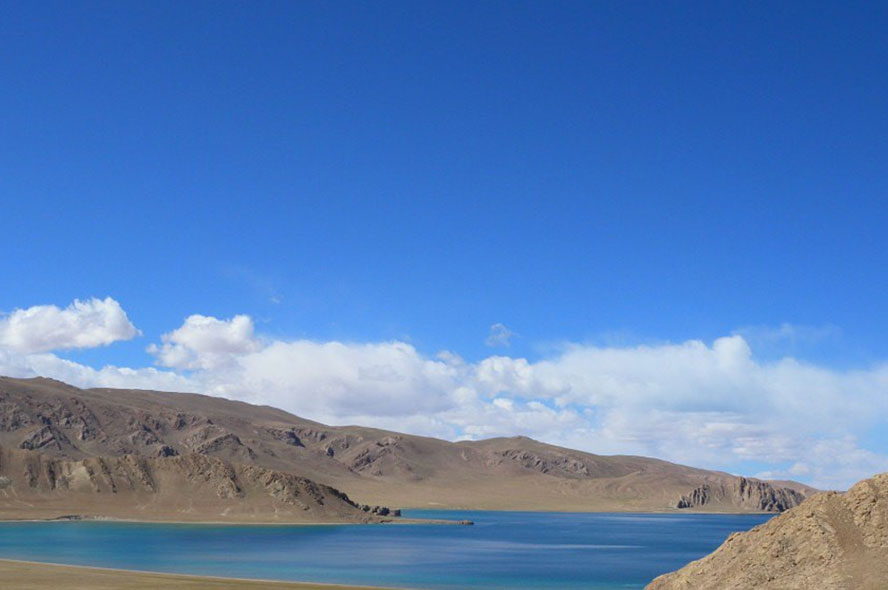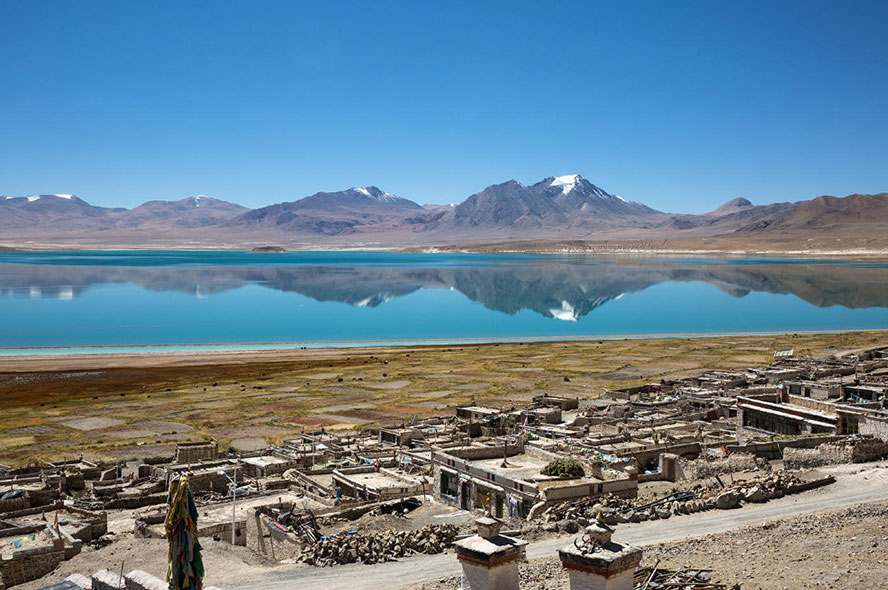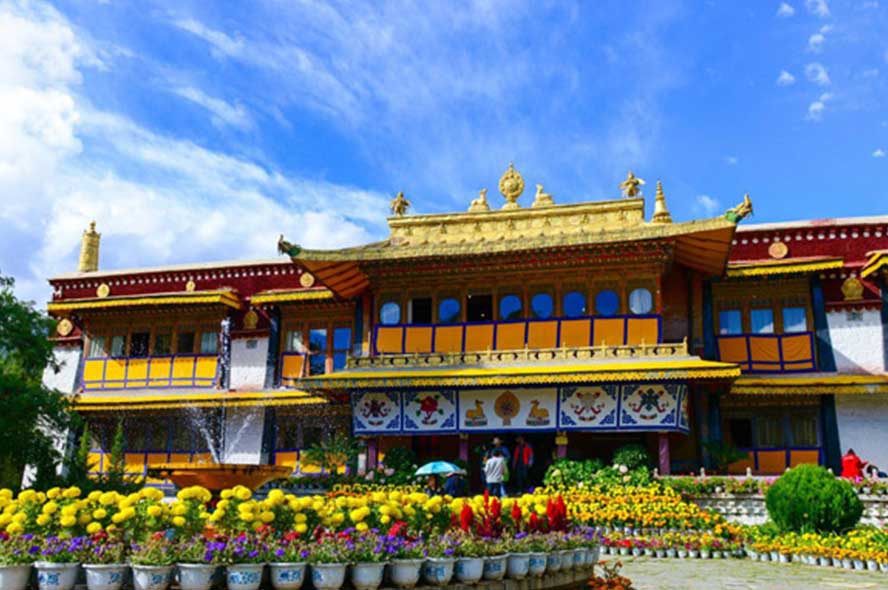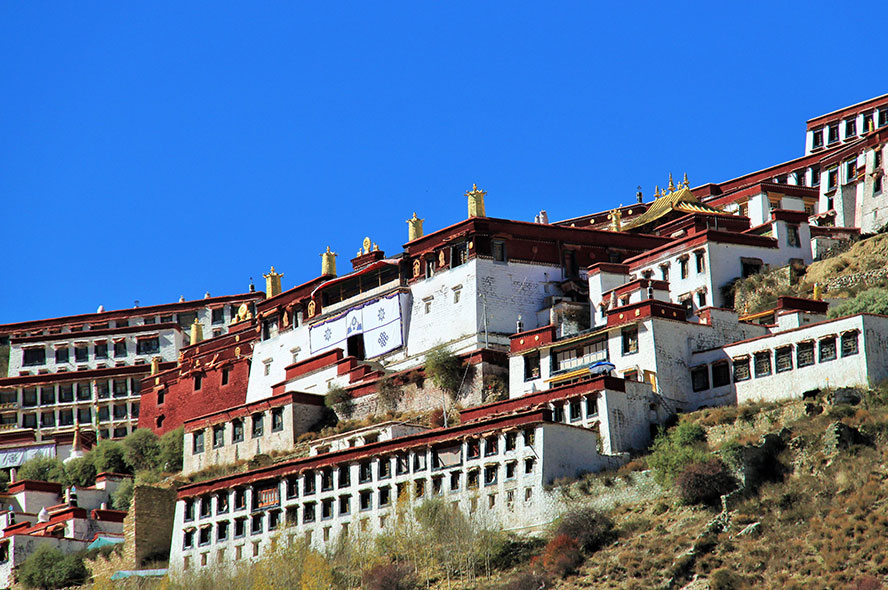As January is the coldest time in Tibet throughout the year, it is not strange that some areas of Tibet are freezing cold during this period. However, what is delighted is that the weather in a large part of the region is warmer than many people think. Even in the cold January, solar radiation in Tibet (especially Lhasa) is relatively stronger than other places in China. The weather in Tibet is mostly dry and windy, featuring with sufficient sunshine, small yearly temperature difference and huge temperature difference between day and night. In January, the temperature at night can drop to as low as -12 degrees Celsius, while the highest temperature in daytime can be as high as 13 degrees Celsius because of the strong sunshine. Therefore, a journey to Tibet in January would be pleasant.
April to October marks the peak season of Tibet tour. But for those who go to Tibet in winter, they can have a special experience by enjoying the innate beauty of the region, as the unique beauty of some places such as Lhasa and Nyingchi can only be appreciated in winter. In a slow pace, weather in Lhasa and Nyingchi is getting warmer in January, while the weather in western areas of Tibet still remains chilly. Tourist attractions such as Namtso Lake and Mount Kailash are blocked because of the heavy snow. But tourists are able to drive all the way to Everest Base Camp (EBC), where they can enjoy the incredible scenery of the world’s highest mountain—Mt. Everest.
One of the greatest advantages of going to Tibet in January is that the journey can save visitors a great deal of money. For example, discounts offered by airline companies, train stations as well as hotels are available in January. Besides, tickets of some attractions are also possible during this period.
Overall Tibet Climate in January
- Average Lowest Temperature: -12℃ (10.4℉)
- Average Highest Temperature: 13℃ (55.4℉)
- Average Temperature: 1 ℃ (33.8℉)
- Average Rainfall: 1 mm (0.04 in)
- Wet Days (Rainfall > 0.1mm): 0
- Relative Humidity: 45 %
Most-Visited Places in Tibet along the Way from Lhasa to Kathmandu via Overland in January
January is not only a time of hibernation for animals, but also for tourist attractions of some other places, among which most of the tourist attractions of Tibet are not included. People can do a lot of things in Tibet even in this cold season, as there is always something taking place in the region throughout the year. What’s more, winter is a season when Tibet looks more beautiful, as the beauty of some Tibetan places can only be appreciated during this period.
January is the best time for those who want to see the glory of the plateau in winter. Visitors are able to learn about the Tibetan life and culture in a more direct and relaxing way. As it is cold in January, the amount of tourists who go to Tibet decreases sharply during the period. So for those who want a less crowded place for traveling, they can go to Tibet in January.
Lhasa Tibet Climate in January
- Average Lowest Temperature: -9 ℃ (15.8℉)
- Average Highest Temperature: 7 ℃ (44.6℉)
- Average Rainfall: 1 mm (0.04 in)
- Rainy Days: 1.5
- Relative Humidity: 70 %
- Average Wind Speed: 12 km/h (7.5 mi/h)
As the essence of Tibet, Lhasa is a must-visit destination for travelers and a perfect place to experience the best culture of Tibet. In Tibetan language, Lhasa means the “Holy Land” or “Buddha Land”. It is also known as the “City of Sunshine”, because sunshine there in daytime lasts longer than almost all the other places in Tibet throughout the year (more than 3000 hours annually). It barely rains in January and the average temperature ranges from -9 to 7 degrees. Thanks to the clear sky and bright sunshine, weather in daytime is comfortably warm in Lhasa in January.
January is a perfect time for those who want to better experience the leisure life of local people in Lhasa. They can drink a cup of tea and chat with them as long as they want, as the city in January is not as crowded as what it is in other months. The most outstanding highlight inside and outside the city should definitely be the magnificent palaces and temples, such as the famous Potala Palace and Jokhang Temple, which are not only centers for Tibetan religions and culture, but also world heritage sites inscribed by the UNESCO in 1994. Besides, the beautiful Lhasa River is also worth a visit. It is the longest tributary of Yarlung Tsangbo River, covering a drainage area of about 32,471 square kilometers, which accounts for about 13.5% of Yarlung Tsangbo River’s total drainage area.
In January, When there is sunshine in daytime, sweaters and fleece jackets will be enough to keep warm. If there is no sunshine in daytime, you need to wear extra thermal underwear to keep out the cold. All the clothes must be buttoned up to ward off the cold wind. When you go outside in the morning or evening, you must pay attention to keep your feet warm. For example, you can wear thermal boots and thick woolen socks to protect your feet.
Namtso Tibet Climate in January
- Average Lowest Temperature: -10 ℃ (14℉)
- Average Highest Temperature: 7 ℃ (44.6℉)
- Average Rainfall: 0 mm
- Rainy Days: 0
Namtso Lake, located at the northwest of Lhasa, is famous for being the highest saltwater lake in the world, the second largest saltwater lake in China (next to Qinghai Lake), and one of the three holy lakes in Tibet (together with Yamdrok Lake and Lake Masarovar). Namtso, known as “Heavenly Lake” in Tibetan language, is often described as the place which is close to heaven because of its high altitude (over 4,700 meters), magnificent beauty, crystal clear water as well as spiritual associations. The lake begins to freeze from December, and will not completely melt until next May. Besides, the road to Namtso Lake from Lhasa is always too slippery for driving during the period. Therefore, the best time to visit Namtso Lake is between May and November.
The wind is strong and cold in Namtso in January, so thermal clothes is essential for a trip to Namtso during this period. In addition, gloves, scarves, hats and cold-weather masks will be much useful to against the strong wind in Namtso. Hotels in Damxung County, the country where Namtso located, may be poor in terms of heating facilities, so you still need to wear thick clothes even when you are in the hotels.
Nyingchi Tibet Climate in January
- Average Lowest Temperature: -5 ℃ (23℉)
- Average Highest Temperature: 8.5 ℃ (47.3℉)
- Average Rainfall: 1.82 mm (0.07 in)
- Rainy Days: 2.8
Nyingchi is a prefecture lying in the southeastern Tibet. January is the coldest month in Nyingchi, yet it is still warmer than other places in Tibet because of its low altitude (the average altitude is about 3,100 meters). The lowest temperature in Nyingchi in January is about 8 degrees Celsius in daytime, and the lowest temperature is about -2 Celsius degrees Celsius at night.
Traveling in Nyingchi is a unique experience. Due to the summer monsoon from Assam and its complex location, climate of Nyingchi changes greatly in a vertical direction. Therefore, visitors can see totally different scenery in different places of Nyingchi. Only when they see the breathtaking scenery in Nyingchi with their own eyes, can they believe that this picturesque and fertile heaven land is located on the barren Qinghai-Tibet Plateau. Nyingchi is blessed with beautiful lakes, deep gorges, and lush plants. That’s why it is renowned as the "East Switzerland". Even in winter, Nyingchi is warmer than other places in Tibet. Therefore, it is worthwhile to visit Nyingchi in January.
As January is among the dry season in Nyingchi, the air is pretty dry during this period. Therefore, unless you want your skin to be chapped, you must carry skin care products all the time during the journey. Although it is warm in daytime, the temperature at night can be pretty low. What’s more, there is no heating in the hotels in Nyingchi, so you should bring sufficient thermal clothes to keep warm at cold night.
Shannan Tibet Climate in January
- Average Lowest Temperature: -10 ℃ (14℉)
- Average Highest Temperature: 6 ℃ (42.8℉)
- Average Rainfall: 0 mm
Shannan, also called Lhoka in Tibetan language, is a prefecture with long history located in the southeastern area of Tibet. In January, the temperature difference between daytime and night varies greatly and tourists need to keep warm at night. When there is warm sunshine in daytime, the temperature can raise to as high as 18 degrees. So Shannan is also one of the best destinations for tourists to go to Tibet in winter months. There are a lot of activities that visitors can do in Shannan during the period. For example, they can trek around the old temples like Samye Monastery outside the city.
Samye Monastery in January
Yamdrok Lake Tibet Climate in January
- Average Lowest Temperature: -12.39 ℃ (9.7℉)
- Average Highest Temperature: 2.53 ℃ (36.5℉)
- Average Rainfall: 0.32 mm (0.01 in)
Yamdrok Lake, located at an altitude of about 4,441 meters and known as the "Coral Lake" because of its coral-like convoluted shape, is one of the three holy lakes in Tibet (together with Namtso Lake and Lake Manasarovar). When Namtso Lake begins to freeze in winter, Yamdrok Lake shows a different kind of beauty in its own way to visitors. The water is sapphire, with a thin layer of ice on the surface. While driving from Lhasa to western Tibet, visitors can get a far view of the lake, which is surrounded by many snow-capped mountains. Walking closely to the lake for a clearer sight, they can see that the pure blue lake is flicking with scale-like ripples in various hues under the sunshine.
Gyantse Tibet Climate in January
- Average Lowest Temperature: -14 ℃ (6.8℉)
- Average Highest Temperature: 5.5 ℃ (41.9℉)
- Average Rainfall: 0.23 mm (0.01 in)
- Rainy Days: 0
- Relative Humidity: 33%
Gyantse, situated on the Sino-Nepalese Friendship Highway, was once a center for politics, economy and transportation in ancient times. Visitors can easily get to Gyantse from Lhasa via the highway. Located at an altitude of 4000 meters, Gyantse enjoys a plateau monsoon climate, featuring with sufficient sunshine and little rainfall in winter. Therefore, the winter in Gyantse is not as cold as what people think, with temperature ranging from -14 to 5.5 degrees Celsius. Gyantse is a place of rich tourist resources. Visitors can go to visit the three most famous historical and cultural relics in this city, namely the Gyanste Fortress, Palcho Monastery and Pala Manor.
Shigatse Tibet Climate in January
- Average Lowest Temperature: -13 ℃ (8.6℉)
- Average Highest Temperature: 6 ℃ (42.8℉)
- Average Rainfall: 0.36 mm (0.02 in)
- Rainy Days: 2
- Relative Humidity: 33 %
- Average Wind Speed: 7.4km/h (4.6 mi/h)
In Tibetan language, Shigatse refers to "the fertile land". It is the second cultural center of Tibet. The weather in Shigatse in January is warmer than many people think, featuring with strong solar radiation, long sunshine duration, and large temperature difference between day and night (-13℃ at night and 6℃ in daytime). Besides, the air in Shigatse is thin and atmospheric pressure is low because of its high altitude. It is convenient to get to Shigatse from Lhasa, as the distance between the two places is only 6 hours’ drive. There are a lot of famous sites that tourists can visit in Shigatse, among which the most famous one is the Tashilhunpo Monastery, the seat of successive Panchen Lamas.
As the temperature difference between day and night is pretty large, we suggested that you bring thermal clothes such as down coats, fleece jackets and sweaters if you plan to go to Shigatse in January. You can wear less when there is sunshine in daytime, but do remember to put on more clothes when the sunshine disappears.
EBC Tibet Climate in January
- Average Lowest Temperature: -15 ℃ (5℉)
- Average Highest Temperature: -5 ℃ (23℉)
- Average Rainfall: 5 mm (0.2 in)
- Rainy Days: 0.2
- Average Wind Speed: 7.4km/h (4.6 mi/h)
The coldest time in the region of Mt. Everest is January, when the average temperature is about -10 degrees Celsius and the lowest temperature can be -30 degrees. Besides, temperature difference between day and night during this period is large (around 15 degrees Celsius). Fortunately, the weather is not that bad because it seldom snows heavily in the region. Therefore, visitors can still go to enjoy the beauty of Mt. Everest from EBC in January.
Weather in the region of Mt. Everest is mostly sunny and the sun is usually shinning brightly. There is also strong and dry wind in the region because of the high altitude. Visitors can do activities like taking pictures of the peak of Mt. Everest from EBC.
When you go to EBC in January, we suggest that you wear clothes as thick as possible. In addition to thermal underwear, sweaters, thick fleece jackets and thicker down coats, you should also bring thermal hat, scarves and gloves to keep your head, neck and hands warm. The wind here is relatively strong during this period, so it would be better to do as few outdoor activities as possible. When the wind is too strong for you to stand outside and see the magnificent Mt. Everest, you can go back to your car and see the mountain from the windows of the car. In this way, you can not only get the view of the mountain, but can also keep yourself warm.
Mt. Kailash Tibet Climate in January
- Average Lowest Temperature: -21℃ (-5.8℉)
- Average Highest Temperature: -8℃ (17.6℉)
- Average Rainfall: 9 mm (0.35 in)
- Rainy Days: 5.2
Mount Kailash is the birthplace of the Yarlung Tsangpo River and the Ganges, a trans-boundary river of Asia which flows through India and Bangladesh and finally pours into the Bay of Bengal. It is said that people who circle around the mountain can wash away their sins of life, which has attracted a lot of pilgrims. Weather conditions in the western areas of Mount Kailash are not as good as those of other places. The wind is so biting that it can chafe your skin. The temperature in January is relatively low, as the highest temperature will normally be lower than zero degree Celsius in daytime and the temperature at night can drop dramatically to as low as -27 degrees Celsius. It is mostly dry in other areas of Tibet. However, things are not the same in the Mount Kailash region, as it often snows here during this period.
Roads to Mount Kailash are usually blocked during this period because of the frequent heavy snows. Therefore, a trip to Mount Kailash in January can be dangerous and risky. For those who want to enjoy the beauty of the world’s most sacred mountain and the accompanying Lake Manasarovar, they are recommended to go there between mid-May and mid-October, when the weather is warmer and roads to the area are open to the public.
Lhasa to Kathmandu via Overland in January
- Kathmandu Average Lowest Temperature: 2.4℃ (36.3℉)
- Kathmandu Average Highest Temperature: 19.1℃ (66.3℉)
- Kathmandu Average Rainfall: 14.4 mm (0.57 in)
- Kathmandu Rainy Days: 2
- Kathmandu Relative Humidity: 79%
- Kathmandu Average Wind Speed: 6.8 km/h (4.2mi/h)
- Gyirong Port Average Lowest Temperature: -7℃ (19.4℉)
- Gyirong Port Average Highest Temperature: -17℃ (1.4℉)
A trip from Lhasa to Kathmandu in January is very popular, as the two places are close to each other and a stay in Kathmandu during this period should be comfortable. The average temperature can be as high as 19℃ (66.2℉) during daytime, and even the lowest temperature is above zero degree Celsius. The air in Kathmandu in January is rather clear, allowing visitors to get an excellent view of the mountain peaks.
Nepal and Tibet are great neighbors sharing much in common. At the same time, they also have different traditions and customs. A trip between the two places was rather difficult before. Thanks to the Friendship Highway and the newly opened Gyirong Port, visitors can now easily travel between the two places. And while driving along the well-paved Friendship Highway, visitors can explore different outstanding landscapes, such as the snowy land in Tibet and the green valley scenery in Nepal.
Tips: For visitors who want to travel from Kathmandu to Lhasa via overland, they will have to apply for both the Tibet Permit and China Group Visa in Kathmandu. With the help of our staff, visitors can get their documents done quickly. One thing to remember is that visitors have to apply for the visa at least 3 days before their tour starts, as it will take 3 working days to finish the process. After handing in the passports, out travel consultants will help you get all the details done.
Tibetan Festivals in January
Shigatse New year, also known as Tsang Losar, is the most significant festival in Tibet in January. The biggest difference between Shigatse New year and traditional Tibetan New Year is that Shigatse New year begins on December 1st of Tibetan calendar, while Tibetan New Year begins on January 1st of Tibetan calendar. If people of Shigatse celebrate the festival just like what other Tibetans do, their activities of crop-planting would be affected. Therefore, people of Shigatse created their own calendar more than 100 years ago for better celebration of the festival. In addition to the time, another difference between Shigatse New year and Tibetan New Year is the food, with dishes made of mutton being dominated cuisines in Shigatse.
Shigatse New Year Celebrations
Another major festival in January in Tibet is the “Meeting of the Eight Guardians”, a festival in Lhasa which is served as a spirit purification in preparation for the coming new year. During the festival, monks with trumpets leaded by Lamas would parade around the Potala Palace and Lhasa. In addition to the monks, there are also “witch dancers” among the procession. They try to chase away evil spirits around the city through their dances as well as the sounds of the blasting trumpets.
Recommended Packages for Tibet Tour in February
In January, tourists may find it warm and comfortable during daytime in Tibet. Yet the weather usually gets cold at night. So for a better experience in Tibet in January, wearing several layers of clothing that can be easily added or removed is a wise choice since temperatures can change greatly between day and night. A down coat is necessary to keep warm when tourists go to visit remote places beyond Lhasa and Shigatse such as the EBC. For people who go to windy places, a windbreaker and a sweater will be much helpful. Besides, other thermal things like gloves, and warm hats are also important for a trip to Tibet in January. Sunglasses and sun protection equipment such as sun hats and high SPF sunscreen are needed to protect visitors from the intense sunlight. What’s more, moisturizer, hand cream and lip balm are also necessary to against the dry weather there.
In case you should encounter rough ground, don’t forget to bring sturdy sneakers, high-quality walking shoes or hiking boots. Daily necessities such as toothbrush and toothpaste should also be brought with you, as it may be difficult to get the ones you want in Tibet in winter months. Besides, you should also prepare a belt bag to keep important documents like your Tibet Permit and China Group Visa, which are of great significance for a trip in Tibet.
Should I Travel to Tibet in January?
Although January is the coldest time of winter months, the weather in Tibet is not as bad nor harsh as many people think. It is cold at night but the weather in daytime is warm because of the strong sunshine. Therefore, people can still do a lot of things and enjoy the beauty of Tibet in daytime. The 6 days and 5 nights Lhasa-Shigatse tour is recommended if you plan to travel to Tibet in January.
Tourists can have better experience in Lhasa than in other Tibetan places during cold seasons. It is one of the warmest places in Tibet in the period and it is less crowded than summer. They can go to explore the secrets of Jokhang Temple and Potala Palace all by themselves. After that, they can go to Nyingchi to enjoy the full view of Namcha Barwa Mountain. Besides, because of the clear sky and little rainfall, tourists can get a better chance to enjoy the breathtaking scenery of Mt. Everest.
Weather in January in Tibet is freezing cold, making it one of the low seasons of Tibet tours. If you want to go to a less crowded place and save as much money as you can, you should definitely go to Tibet in January, when favorable discounts are offered by hotels, restaurants, airline companies, and train stations.

















































 Data in submission...
Data in submission...